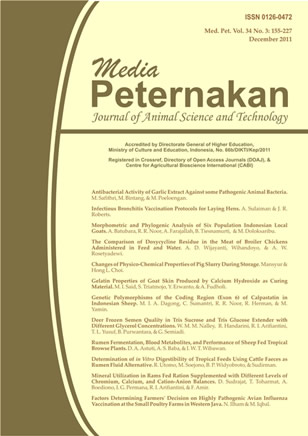-
D Sudrajat
-
T Toharmat
-
A Boediono
-
I G Permana
-
R I Arifiantini
-
F Amir
Keywords:
chromium, calcium, kation-anion balance, Garut rams
Abstract
Chromium (Cr) is an essential mineral for ruminants. Its metabolism and interactions with other minerals has not been widely known. This experiment was designed to evaluate the utilization of minerals and growth of Garut ram fed ration supplemented with Cr and different Dietary Cation Anion Balance (DCAB) and Ca level. Dietary treatments, namely: R0 (Ration with DCAB+14); R1 (Ration with DCAB+14 + Cr 3ppm,); R2 (Ration with DCAB 0 + Ca); R3 (Ration with DCAB 0 + Cr 3 ppm + Ca), were allocated in twenty four of 1.5-2 years old Garut rams in a randomized block design. The results showed that Cr supplementation in rations containing different levels of Ca did not affect feed intake, body weight gain, and dry matter digestibility, but reduced the absorption of Cr and Ca of the low Ca diet. Supplementation of Cr had no effect on Cr, Ca, Zn, and Mg status in blood and semen of the rams. Level of Cr intake had negative correlation with Ca absorption and positive correlation with blood Cr levels. There is a positive relationship between level of Ca intake with Ca and Mg absorption and blood Ca and Zn levels. Intake of Cr and Ca was not related to the semen Cr and Ca levels.
Author Biographies
D Sudrajat
Department of Animal Nutrition and Feed Technology, Graduate School, Bogor Agricultural University
Department of Animal Science, Faculty of Agribusiness and Food Technology, University of Djuanda Jln. Tol Ciawi No. 1, Bogor 16720, Indonesia
T Toharmat
Department of Animal Nutrition and Feed Technology, Faculty of Animal Science, Bogor Agricultural University
A Boediono
Department of Veterinary Clinic, Reproduction, and Pathology, Faculty of Veterinary Science, Bogor Agricultural University
I G Permana
Department of Animal Nutrition and Feed Technology, Faculty of Animal Science, Bogor Agricultural University
R I Arifiantini
Department of Anatomy, Physiology, and Pharmacology, Faculty of Veterinary Science,
Bogor Agricultural University
F Amir
Department of Animal Nutrition and Feed Technology, Faculty of Animal Science, Bogor Agricultural University
Authors submitting manuscripts should understand and agree that copyright of manuscripts published are held by Media Peternakan. The statement to release the copyright to Media Peternakan is stated in Form A. This work is licensed under a Creative Commons Attribution-ShareAlike 4.0 International License (CC BY-SA) where Authors and Readers can copy and redistribute the material in any medium or format, as well as remix, transform, and build upon the material for any purpose, but they must give appropriate credit (cite to the article or content), provide a link to the license, and indicate if changes were made. If you remix, transform, or build upon the material, you must distribute your contributions under the same license as the original.



